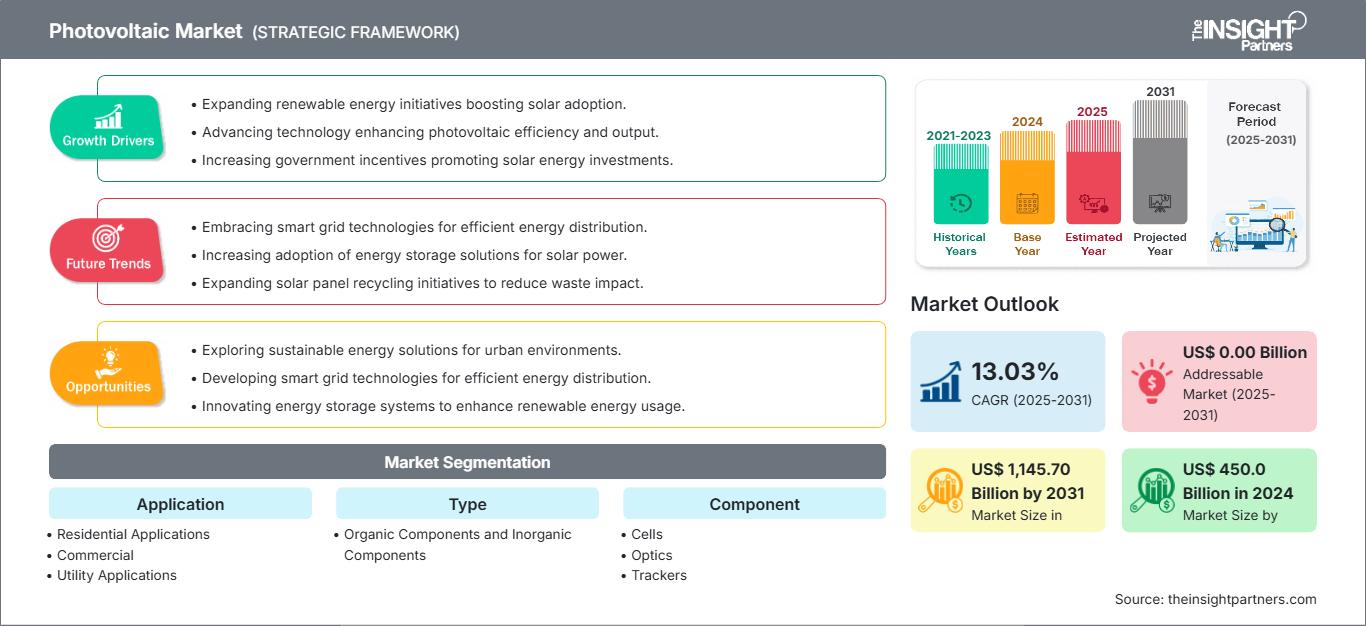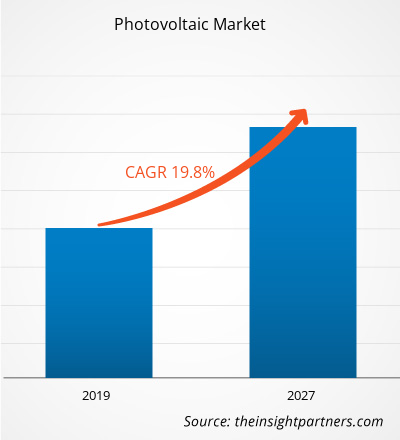Si prevede che il mercato fotovoltaico raggiungerà i 1.145,70 miliardi di dollari entro il 2031, rispetto ai 450 miliardi di dollari del 2024. Si prevede che il mercato registrerà un CAGR del 13,03% tra il 2025 e il 2031.
Sulla scia dello sviluppo tecnologico e dell'attenzione verso la crescente tendenza della tecnologia solare fotovoltaica, i governi tedesco e spagnolo hanno definito solidi quadri politici, come chiari obiettivi nazionali, incentivi interessanti per promuovere i consumi e piani integrati per promuovere lo sviluppo tecnologico e l'adozione della tecnologia fotovoltaica nel settore dell'energia solare, stimolando la crescita del mercato fotovoltaico. Nell'area Asia-Pacifico, i governi hanno adottato diverse iniziative per ridurre al minimo i costi di installazione complessivi e massimizzare i benefici di vasta portata di un'opzione off-grid nell'elettrificazione rurale, oltre a rafforzare l'attenzione verso condizioni ambientali sostenibili. Inoltre, diversi paesi, come la Cina, hanno adottato politiche per migliorare il livello di produzione di energia solare fotovoltaica. Pertanto, i fattori sopra menzionati contribuiscono alla crescita del mercato fotovoltaico.
L'energia fotovoltaica (FV) sta crescendo a un ritmo rapido, contribuendo in modo significativo al bilancio energetico dei sistemi energetici dell'economia. Questi sistemi si sono affermati come una tecnologia matura utilizzata per la produzione di energia elettrica tradizionale e trainano la crescita del mercato fotovoltaico. Tuttavia, i sistemi fotovoltaici alimentati a energia solare generano elettricità in eccesso. I fornitori di energia elettrica di tutto il mondo offrono il net metering, ovvero un sistema in cui l'elettricità in eccesso prodotta da sistemi di energia rinnovabile connessi alla rete viene restituita al contatore. Ciò evita sprechi e migliora la distribuzione dell'energia in base alle necessità. I sistemi fotovoltaici che utilizzano la tecnologia di rete rappresentano circa il 99% della capacità installata rispetto ai sistemi stand-alone, che richiedono batterie. Il fotovoltaico connesso alla rete e senza batterie è considerato una soluzione conveniente e richiede meno manutenzione, il che aumenta l'adozione di prodotti basati sul fotovoltaico e quindi determina la quota di mercato del fotovoltaico.
Inoltre, per chi passa ai pannelli solari, i sistemi fotovoltaici connessi alla rete sono considerati un'opzione conveniente per soddisfare l'intero fabbisogno elettrico. Inoltre, l'installazione di sistemi stand-alone è un'attività piuttosto laboriosa e richiede più capitale e spazio rispetto ai sistemi fotovoltaici connessi alla rete. Pertanto, l'aumento dell'adozione di sistemi fotovoltaici connessi alla rete stimolerà ulteriormente la crescita del mercato fotovoltaico. Inoltre, con la crescente attenzione all'uso di energie rinnovabili e la tendenza al risparmio energetico, i sistemi fotovoltaici connessi alla rete si dimostrano un'opzione economicamente sostenibile. Tuttavia, la loro applicabilità è attualmente piuttosto limitata e potrebbe aumentare nei prossimi anni.
Potrai personalizzare gratuitamente qualsiasi rapporto, comprese parti di questo rapporto, o analisi a livello di paese, pacchetto dati Excel, oltre a usufruire di grandi offerte e sconti per start-up e università
Mercato fotovoltaico: Approfondimenti strategici

-
Ottieni le principali tendenze chiave del mercato di questo rapporto.Questo campione GRATUITO includerà l'analisi dei dati, che vanno dalle tendenze di mercato alle stime e alle previsioni.
Approfondimenti sul mercato del fotovoltaico: crescente utilizzo di vernici fotovoltaiche per lo sfruttamento dell'energia solare
La volatilità dei prezzi del petrolio greggio, le preoccupazioni ambientali legate all'energia idroelettrica e il rischio associato alle radiazioni nucleari hanno spostato l'onere di soddisfare la domanda energetica sull'energia solare. I progressi tecnologici, l'attenzione alla riduzione dei costi di installazione e il rapido utilizzo della tecnologia fotovoltaica nelle applicazioni residenziali sono tra i fattori che stanno ridefinendo l'uso della tecnologia fotovoltaica. Nell'era del crescente utilizzo dell'energia solare, l'introduzione delle vernici solari è diventata un risultato notevole. Le vernici solari, o comunemente note come vernici fotovoltaiche, possono essere applicate su qualsiasi superficie per intrappolare l'energia del sole e convertirla in elettricità. I componenti della vernice sono combinati con miliardi di particelle di materiale fotosensibile sospese al suo interno, il che potrebbe contribuire a trasformare una normale vernice in una vernice super-potente in grado di catturare energia. L'uso di vernici fotovoltaiche può ridurre efficacemente la dipendenza dal metallo e dalla combinazione del principio del diodo a giunzione pn con l'effetto termoelettrico per produrre energia elettrica dall'esposizione solare. Ciò porterà quindi a un aumento dell'adozione dell'energia solare e, di conseguenza, a una crescita del mercato fotovoltaico. Aziende come Onyx Solar Group LLC puntano allo sviluppo tecnologico concentrandosi su attività di ricerca e sviluppo e collaborando con istituti per sviluppare vernici fotovoltaiche e quindi guidare la crescita del mercato fotovoltaico. Sebbene le vernici solari o la tecnologia delle vernici fotovoltaiche siano attualmente in fase iniziale, è probabile che acquisiscano popolarità nel prossimo futuro. Con il progresso e l'avanzamento dell'industria solare, le vernici solari hanno un'eccellente opportunità di diventare un'opzione ragionevole. Pertanto, i fattori sopra menzionati stanno creando un'opportunità per il mercato fotovoltaico.
Approfondimenti regionali sul mercato fotovoltaico
Le tendenze regionali e i fattori che influenzano il mercato fotovoltaico durante il periodo di previsione sono stati ampiamente spiegati dagli analisti di The Insight Partners. Questa sezione analizza anche i segmenti e la geografia del mercato fotovoltaico in Nord America, Europa, Asia-Pacifico, Medio Oriente e Africa, America Meridionale e Centrale.
Ambito del rapporto sul mercato fotovoltaico
| Attributo del rapporto | Dettagli |
|---|---|
| Dimensioni del mercato in | US$ 1,145.70 Billion by 2031 |
| Dimensioni del mercato per | US$ 450.0 Billion in 2024 |
| CAGR globale (2025 - 2031) | 13.03% |
| Dati storici | 2021-2023 |
| Periodo di previsione | 2025-2031 |
| Segmenti coperti |
By Applicazione
|
| Regioni e paesi coperti |
Nord America
|
| Leader di mercato e profili aziendali chiave |
|
Densità degli operatori del mercato fotovoltaico: comprendere il suo impatto sulle dinamiche aziendali
Il mercato del fotovoltaico è in rapida crescita, trainato dalla crescente domanda degli utenti finali, dovuta a fattori quali l'evoluzione delle preferenze dei consumatori, i progressi tecnologici e una maggiore consapevolezza dei vantaggi del prodotto. Con l'aumento della domanda, le aziende stanno ampliando la propria offerta, innovando per soddisfare le esigenze dei consumatori e sfruttando le tendenze emergenti, alimentando ulteriormente la crescita del mercato.

- Ottieni il Mercato fotovoltaico Panoramica dei principali attori chiave
Approfondimenti di mercato basati sui componenti
Le celle fotovoltaiche sono costituite da due o più strati sottili di materiale semiconduttore. Il materiale più comunemente utilizzato nelle celle fotovoltaiche è il silicio. Le celle semiconduttrici sono esposte alla luce per generare cariche elettriche, che possono essere condotte da contatti metallici come corrente continua (CC); pertanto, la crescente adozione di celle fotovoltaiche aumenterà le dimensioni del mercato fotovoltaico globale nel periodo di previsione.
Gli operatori che operano nel mercato fotovoltaico adottano strategie come fusioni, acquisizioni e iniziative di mercato per mantenere le proprie posizioni nel mercato fotovoltaico. Di seguito sono elencati alcuni sviluppi dei principali operatori:
- Nel 2021, Royal Dutch Shell PLC ha inaugurato il suo impianto solare Qabas da 25 megawatt. Il progetto, composto da oltre 88.000 moduli solari, si trova su un'area di 50 ettari nella zona franca di Sohar, nell'Oman settentrionale. Contribuisce alla riduzione di circa 25.000 tonnellate di emissioni di CO2 all'anno.
- Nel 2021, l'impianto fotovoltaico Sakaka IPP da 300 MW, il primo progetto di energia rinnovabile su scala industriale del Paese, è stato inaugurato da ACWA Power con un costo di 1,2 miliardi di SAR. ACWA Power si è aggiudicata il progetto a una tariffa record mondiale di 2,3417 centesimi di dollaro USA per kWh (8,781 halalas per kWh).
- Analisi storica (2 anni), anno base, previsione (7 anni) con CAGR
- Analisi PEST e SWOT
- Valore/volume delle dimensioni del mercato - Globale, Regionale, Nazionale
- Industria e panorama competitivo
- Set di dati Excel
Report recenti
Testimonianze
Motivo dell'acquisto
- Processo decisionale informato
- Comprensione delle dinamiche di mercato
- Analisi competitiva
- Analisi dei clienti
- Previsioni di mercato
- Mitigazione del rischio
- Pianificazione strategica
- Giustificazione degli investimenti
- Identificazione dei mercati emergenti
- Miglioramento delle strategie di marketing
- Aumento dell'efficienza operativa
- Allineamento alle tendenze normative






















 Ottieni un campione gratuito per - Mercato fotovoltaico
Ottieni un campione gratuito per - Mercato fotovoltaico